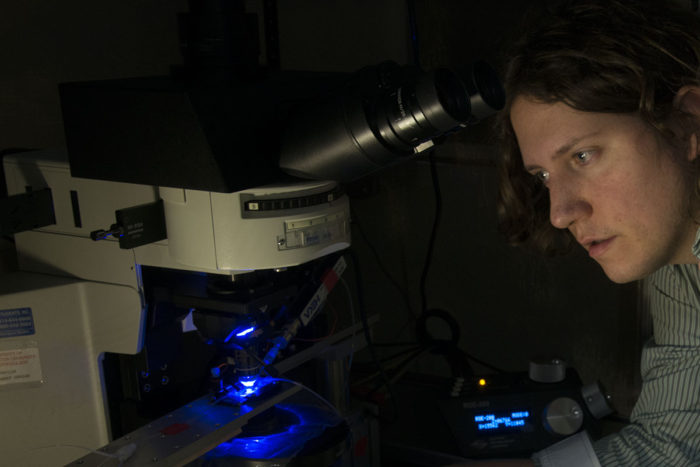$3.8 million to help explore brain’s circuitry using light
Researchers aim to understand how brain is wired
 Robert Boston
Robert BostonMichael R. Bruchas, PhD, analyzes the effects of light on nerve cells from mice. As part of a new grant, Bruchas will work with collaborators to use light-sensitive proteins from animals to create receptors on brain cells that can be turned on or off with light.

As part of the White House BRAIN Initiative, researchers at Washington University School of Medicine in St. Louis have received two grants to develop tools to map and activate pathways in the brain using light.
With $3.8 million in funding from the National Institutes of Health (NIH), the researchers, with collaborators at the University of California, San Diego, School of Medicine and the University of Illinois at Urbana-Champaign, will study how light-sensitive proteins can be used to control specific brain circuits. The goal is to understand how the brain is wired to regulate responses to stress, including anxiety and depression.
“Many animal proteins have built-in ways to respond to light, and we want to harness those light-sensitive properties and use them to get cells in the brain to respond to light,” said principal investigator Michael R. Bruchas, PhD, an associate professor of anesthesiology and of neuroscience. “That way we can use light to turn cells on and off to better understand how things are connected.”
The BRAIN (Brain Research through Advancing Innovative Neurotechnologies) Initiative was launched by President Barack Obama in 2013 with the aim of furthering cutting-edge research to help scientists better understand the human brain.
One of the new projects builds on previous research in several Washington University laboratories, including those of Bruchas, N. Gautam, PhD, a professor of anesthesiology and of genetics, and Robert W. Gereau IV, PhD, the Dr. Seymour and Rose T. Brown Professor of Anesthesiology and director of the Washington University Pain Center.
That work will be conducted in collaboration with Roger K. Sunahara, PhD, of the University of California, San Diego, School of Medicine, a leading expert in the structure of the types of receptors found on light-sensitive proteins. His laboratory will focus on the biochemical design of those light-sensitive proteins, called opsins.
The researchers will take advantage of the structural properties of opsins, found in photoreceptor cells in the eyes of people and animals. Opsins ultimately make it possible to see, as well as to engineer light-activated triggers in neurons outside of the visual system.
The researchers also have developed wireless, micro-LED devices, about the width of a human hair, that can be implanted into mice to activate nerve cells with light. Expanding on that prior work in a second project, the Bruchas lab – along with John A. Rogers, PhD, and Paul V. Braun, PhD, of the University of Illinois — were awarded a two-year, pilot BRAIN Initiative grant to develop wireless, micro-LED-based sensors that detect changes in specific neural pathways during typical mouse behaviors, such as grooming, or social behaviors designed to communicate anxiety, dominance or excitement.
The research will involve additional studies of the protein structure of opsins from animals as diverse as goldfish, lampreys and birds, taking advantage of varying wavelengths of light detected by opsins in different animals. Some of the proteins can be activated by visible light, while others are sensitive to light that human eyes can’t see.
“Typically, we’ve used blue light to activate neurons in the brain, but with other opsins, we want to explore whether we can use other colors, too,” Bruchas said. “For example, light from the far red end of the spectrum doesn’t scatter as much in tissue as blue light, which could allow us to map and study the function of cells that we haven’t been able to reach previously because the light signals from far red light will be able to penetrate more layers of brain cells.”
Bruchas and his collaborators will combine opsin proteins from several organisms with receptor proteins from nerve cells to create new types of nerve cell receptors that can be turned off and on with various wavelengths of light. Using different proteins and wavelengths, Bruchas said it should be possible to turn brain circuits on and off as if using a light switch — and to use light to manipulate cells more gradually, as if using a dimmer switch.
“There are many events in the brain that are pretty black and white; the cells and circuits are either on or off,” he said. “But a number of other mechanisms that regulate behavior are much more gradual and modulated, and we think using light to learn how the circuits work also could help identify new targets for drugs and provide new ways to deliver treatments for psychiatric disorders such as anxiety and depression.”






